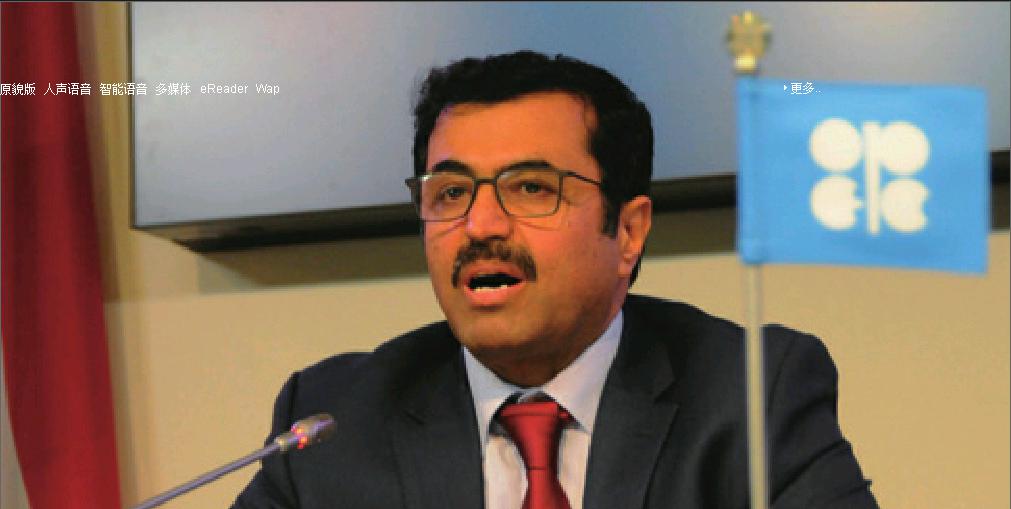Running on Fumes
2017-03-01ByMeiXinyu
By+Mei+Xinyu

Ministers of major oil exporting countries claimed to have made “historic”progress following the Organization of the Petroleum Exporting Countries (OPECs) agreement in Vienna on November 30, 2016, to reduce their oil production by 1.2 million barrels per day. Subsequently, on December 10, 11 non-OPEC oil producers also agreed to cut their production by 558,000 barrels a day. This is the first time in history that so many oil producing countries have worked so hard to achieve a common goal.
But can their goal of slashing turnout to push up oil prices be realized? Critics throughout the world have cast doubts over the project.
The basis for their skepticism lies in the effect such a policy will have on both the supply side and the demand side.
Regarding the supply side of the crude oil and energy market, signatories commitment to reduce their output may not be carried out to the full extent, since they are playing “tricks” similar to raising prices first and then offering discounts on their products. This deal might also be regarded by nonsignatory countries as a good opportunity to increase their oil output. The United States in particular, which has the strength to break the monopoly held by traditional oil producing countries with its production of shale gas, has in recent years effectively curbed high oil prices. Furthermore, President-elect Donald Trumps future administration is likely to further enhance the competitiveness of the United States in the shale gas market.
On the demand side, world economic growth has not been robust, and is mired in uncertainties. Significant oil price rebound since the second quarter of 2016, Chinas relaxation of rigid controls on coal production, and Trumps commitment to boost the U.S. coal industry will work in concert to encour- age the replacement of oil with natural gas and coal. Moreover, hikes in the interest rate by the U.S. Federal Reserve in December 2016 and beyond will further curb both actual and speculative demand for oil.
Output cut not ensured
Actually, the pledge by OPEC members to reduce production by 1.2 million barrels per day, as well as non-OPEC oil producers plans to cut their own output may not be as significant as they make it out to be. This is because almost all of the countries involved had been increasing their production at full steam for months before signing the agreement, in an effort to seize as much market share as possible.
Consider Iran, which had its economic sanctions removed only in 2016. Iran urgently needs to expand its output and export of oil to increase its revenue and improve the domestic economy. Trump and his team have been against the Iran nuclear deal, increasing Irans sense of crisis and stimulating the country to accelerate oil production and export in order to accumulate as much revenue as possible before Trump takes office.
Also, OPEC members pumped a record-high 34.2 million barrels per day in November 2016, 300,000 barrels more than in October, according to a monthly report issued by the International Energy Agency on December 13, 2016. Of them, Saudi Arabia produced a record-high 10.63 million barrels per day, 70,000 barrels more than in October. OPEC therefore has to cut daily output by 1.7 million barrels in order to reach the daily oil production ceiling of 32.5 million barrels set by their agreement.
Signatory countries have no motivation to fulfill their commitment after their significant increase in output. Moreover, OPEC doesnt have any effective way of enforcing the policys execution, let alone control the actions of non-OPEC oil producers.
Throughout the 17 times that OPEC reduced production, between 1982 and 2009, the actual cuts were usually around 60 percent of what had been agreed on. Russia took part in four cutbacks since 1998, but really reduced its oil output only twice in 1998. What is more, in 1999 and 2002, Russias commitment to belt-tightening actually ended up with remarkable increases in production. Its true that this time OPEC will set up a joint ministerial committee to oversee the compliance of the agreement, and Mohammad Barkindo, OPECs Secretary General, has also told journalists that this will make the Vienna agreement on oil output cuts measurable and verifiable. But the real effect remains to be seen.
As for non-signatory countries, they will certainly make use of this opportunity to increase their oil yields, especially Canada and the United States.
On November 29, 2016, a day prior to the signing of the Vienna agreement, Canada, the worlds sixth largest oil producer, approved two major oil pipeline projects in the country, which will add roughly 1 million barrels a day to the market.
In addition, the U.S. shale gas industry performed astonishingly well despite a twoyear slump in oil prices. It has not been forced out of the market as Saudi Arabia had expected. Instead it successfully reduced costs and improved productivity. Although some shale gas companies suspended production, they can easily resume performance at any time. Moreover, aside from Trumps vow to significantly relax or abolish restrictions on domestic oil and gas exploitation, he has picked Montana Congressman Ryan Zinke, whos been an advocate of fossil fuel development on U.S. federal land and waters, as secretary of the interior. This means that oil and gas production costs in the United States are likely to be reduced even further, enhancing its competitiveness in the international market and increasing production capacity.

For those reasons, it is likely that the global oil output in 2017 will surpass that of 2016. The price of oil will definitely decline considering that the Panama Canal expansion project has been completed, and therefore oil and gas from the United States, Venezuela and Brazil are able to enter the East Asian market at competitive transport costs. These new competitors will shake up the market, as indicated by the first shipment of liquefied natural gas exported by the United States through the Panama Canal to south Chinas Guangdong Province in June 2016, the worlds fastest-growing energy importer.
Tepid demand
If any oil cartel is to have a strict enforcement of orders and prohibitions, it must have a swing producer with large enough production capacity that is willing to suffer losses from output cuts. Saudi Arabia had long been playing such a role.
But during the oil price collapse in the past two years, due to economic, political and military changes in the country and the region, Saudi Arabia had adopted the strategy of preserving its market share rather than sustaining oil prices.
Saudi Arabia has agreed to curtail oil production this time because its state-owned oil company Saudi Aramco is preparing its initial public offering. Reducing output to push up oil prices will help boost its share price. However, if Saudi Arabia finds that the cuts merely benefit its rivals, it may at any time revert to the “market share first” strategy.
In terms of the demand side, oil produc- ing countries should not be too optimistic because world economic growth is currently not strong enough. Also, the outcome of Italys constitutional referendum in December 2016 and some other factors have been a source of great uncertainties in Europe. And China, the worlds largest oil importer, will see very slight or even no actual growth in its consumption of refined oil.
The nominal growth of crude oil imports by China is high, but quite a lot of that is used to make up for the shortfall caused by domestic output reduction, while the rest is sent to be refined in domestic factories for export.
In 2015, Chinas exports of refined oil soared by 52 percent, reaching 36.15 million tons. In the first nine months of 2016, refined oil exports grew by 21.2 percent to 34.05 million tons.
In addition, some of the crude oil imported by China when the price was low became part of the countrys domestic reserves. Therefore while OPEC is cutting output and international oil prices resume growth, China can suspend increasing its oil reserves until the output cut deal expires or is abandoned.
The changes in the U.S. monetary policy should be taken into consideration as well. Following the U.S. Federal Reserves decision to raise interest rates in December, the number of expected rate hikes in 2017 has increased to three, which will inevitably put a damper on speculation in the bulk commodity market.
In the meantime, interest rate hikes by the Fed will accelerate capital flows to the United States from emerging markets, and then intensify economic turmoil in the latter. This will curb energy demand from emerging economies which have the fastest growth in demand.
OPEC is undoubtedly the most influential international cartel in the global market. Since its inception, OPEC has influenced international oil prices significantly by controlling oil output quotas. Oil prices could not have been so high without such intervention. However, it is impossible to hold a monopoly perpetually. Both the process it took to reach this deal and the execution of its policies in the future will demonstrate the decline of the cartel, rather than its strength.
